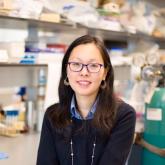Free-Standing Photocrosslinked Protein Polymer Hydrogels for Sustained Drug Release
This research was conducted by Jin Kim Montclare, Professor of Chemical and Biomolecular Engineering; and former students Yao Wang, a recent Ph. D. graduate, and Xiaole Wang, a former M.S. student.
Protein hydrogels, 3-dimensional macromolecular structures that do not dissolve in water (in spite of being hydrophilic), can hold large quantities of aqueous solutions due to the network formed from chemical or physical crosslinking. Partly because of this they have many medical applications including tissue engineering, wound healing and drug delivery.
These materials can be synthesized by crosslinking polymers chemically via covalent bonds, or physically via non-covalent interactions, or a mixture of both. One way of doing this is through photo-initiated crosslinking, wherein chemically inert groups become photo-reactive once exposed to certain wavelengths of light.
“The advantage of employing photochemical reactive groups over traditional chemical reagents is that they give the user spatiotemporal control over polymerization,“ said Montclare. “In other words, the biopolymers bearing the photocrosslinkers can be generated and crosslinked at some later step under various conditions to achieve control over encapsulation and release of therapeutic agents.”
In this research, the team designed a macromolecular triblock polymer comprising two different self-assembling domains derived from elastin protein (E) and coiled-coil protein (C), that can be photopolymerized due to an a NHS-diazirine (D) crosslinker to produce a CEC-D hydrogel.
In the work, “Free-Standing Photocrosslinked Protein Polymer Hydrogels for Sustained Drug Release,” in Biomacromolecules, a publication of the American Chemical Society, the investigators determined the best photocrosslinker concentration and exposure time necessary to create this independent hydrogel.
The researchers found that, overall, CEC-D hydrogel exhibits comparable characteristics, including stability, drug release profile, and elastic behavior to other hydrogels.
Because it can be used for drug delivery with high encapsulation and a low but significant release of curcumin, CEC-D has been proven to be capable of a sustained release of a given drug over a week's time.






